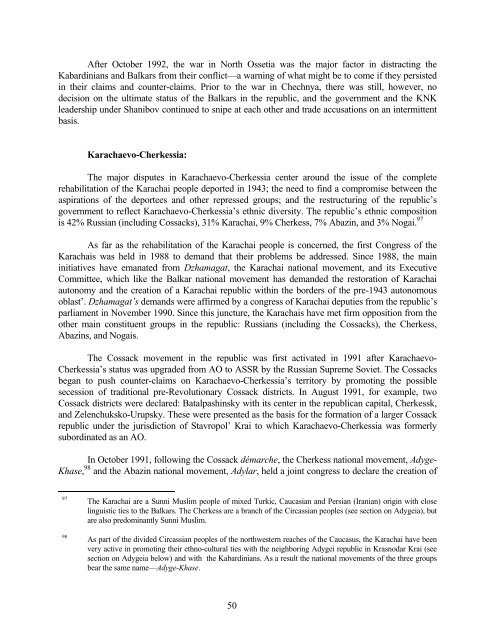RUSSIA'S TINDERBOX - Belfer Center for Science and International ...
RUSSIA'S TINDERBOX - Belfer Center for Science and International ...
RUSSIA'S TINDERBOX - Belfer Center for Science and International ...
You also want an ePaper? Increase the reach of your titles
YUMPU automatically turns print PDFs into web optimized ePapers that Google loves.
After October 1992, the war in North Ossetia was the major factor in distracting the<br />
Kabardinians <strong>and</strong> Balkars from their conflict—a warning of what might be to come if they persisted<br />
in their claims <strong>and</strong> counter-claims. Prior to the war in Chechnya, there was still, however, no<br />
decision on the ultimate status of the Balkars in the republic, <strong>and</strong> the government <strong>and</strong> the KNK<br />
leadership under Shanibov continued to snipe at each other <strong>and</strong> trade accusations on an intermittent<br />
basis.<br />
Karachaevo-Cherkessia:<br />
The major disputes in Karachaevo-Cherkessia center around the issue of the complete<br />
rehabilitation of the Karachai people deported in 1943; the need to find a compromise between the<br />
aspirations of the deportees <strong>and</strong> other repressed groups; <strong>and</strong> the restructuring of the republic’s<br />
government to reflect Karachaevo-Cherkessia’s ethnic diversity. The republic’s ethnic composition<br />
is 42% Russian (including Cossacks), 31% Karachai, 9% Cherkess, 7% Abazin, <strong>and</strong> 3% Nogai. 97<br />
As far as the rehabilitation of the Karachai people is concerned, the first Congress of the<br />
Karachais was held in 1988 to dem<strong>and</strong> that their problems be addressed. Since 1988, the main<br />
initiatives have emanated from Dzhamagat, the Karachai national movement, <strong>and</strong> its Executive<br />
Committee, which like the Balkar national movement has dem<strong>and</strong>ed the restoration of Karachai<br />
autonomy <strong>and</strong> the creation of a Karachai republic within the borders of the pre-1943 autonomous<br />
oblast’. Dzhamagat’s dem<strong>and</strong>s were affirmed by a congress of Karachai deputies from the republic’s<br />
parliament in November 1990. Since this juncture, the Karachais have met firm opposition from the<br />
other main constituent groups in the republic: Russians (including the Cossacks), the Cherkess,<br />
Abazins, <strong>and</strong> Nogais.<br />
The Cossack movement in the republic was first activated in 1991 after Karachaevo-<br />
Cherkessia’s status was upgraded from AO to ASSR by the Russian Supreme Soviet. The Cossacks<br />
began to push counter-claims on Karachaevo-Cherkessia’s territory by promoting the possible<br />
secession of traditional pre-Revolutionary Cossack districts. In August 1991, <strong>for</strong> example, two<br />
Cossack districts were declared: Batalpashinsky with its center in the republican capital, Cherkessk,<br />
<strong>and</strong> Zelenchuksko-Urupsky. These were presented as the basis <strong>for</strong> the <strong>for</strong>mation of a larger Cossack<br />
republic under the jurisdiction of Stavropol’ Krai to which Karachaevo-Cherkessia was <strong>for</strong>merly<br />
subordinated as an AO.<br />
In October 1991, following the Cossack démarche, the Cherkess national movement, Adyge-<br />
Khase, 98 <strong>and</strong> the Abazin national movement, Adylar, held a joint congress to declare the creation of<br />
97 The Karachai are a Sunni Muslim people of mixed Turkic, Caucasian <strong>and</strong> Persian (Iranian) origin with close<br />
linguistic ties to the Balkars. The Cherkess are a branch of the Circassian peoples (see section on Adygeia), but<br />
are also predominantly Sunni Muslim.<br />
98 As part of the divided Circassian peoples of the northwestern reaches of the Caucasus, the Karachai have been<br />
very active in promoting their ethno-cultural ties with the neighboring Adygei republic in Krasnodar Krai (see<br />
section on Adygeia below) <strong>and</strong> with the Kabardinians. As a result the national movements of the three groups<br />
bear the same name––Adyge-Khase.<br />
50
















